Discover 50 hidden attractions, cool sights, and unusual things to do in Lithuania. Don't miss out on these must-see attractions: Vilnius Castle Complex (Vilnius), Presidential Palace (Vilnius) or Verkiai Palace (Vilnius).
Below, you can find the list of the most amazing places you should visit in Lithuania.
Table of Contents
Vilnius Castle Complex, Vilnius

Also known as: Gedimino pilis
The Vilnius Castle Complex is a group of cultural, and historic structures on the left bank of the Neris River, near its confluence with the Vilnia River, in Vilnius, Lithuania. The buildings, which evolved between the 10th and 18th centuries, were one of Lithuania's major defensive structures.
The complex consisted of three castles: the Upper, the Lower, and the Crooked (Lithuanian: Kreivoji pilis). The Crooked Castle was burned down by the Teutonic Knights in 1390 and was never rebuilt. The Vilnius Castles were attacked several times by the Teutonic Order after 1390, but they did not succeed in taking the entire complex. Its complete capture occurred for the first time during the 1655 Battle of Vilnius. Soon afterwards, the severely damaged castles lost their importance, and many buildings were abandoned. During the Tsarist annexation, several historic buildings were demolished; many more were damaged during the fortress construction in the 19th century.
Today, the remaining Gediminas Tower is a major symbol of the city of Vilnius and of the nation itself. Annually, on 1 January, the Lithuanian tricolor is hoisted on Gediminas Tower to commemorate Flag Day. The complex is part of the National Museum of Lithuania, one of the largest museums in the country.[1]
Address: Arsenalo g. 5, Vilnius
Presidential Palace, Vilnius
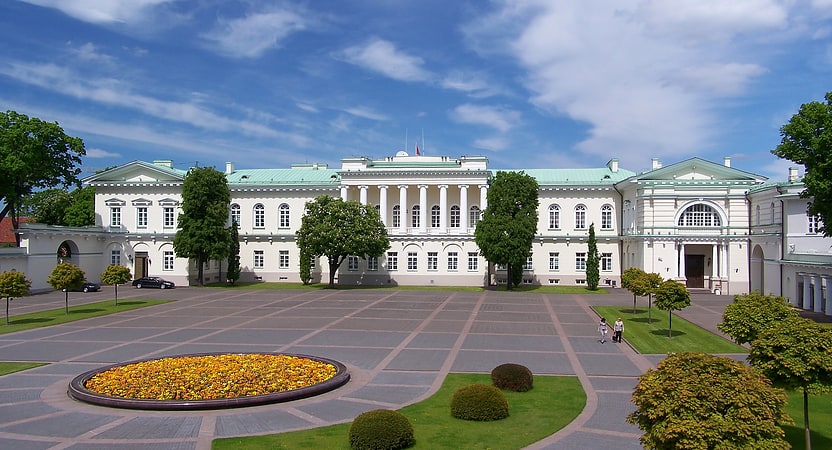
Also known as: Lietuvos Respublikos prezidentūra
Presidential palace in Vilnius, Lithuania. The Presidential Palace, located in Vilnius Old Town, is the official office of the President of Lithuania. The palace dates back to the 14th century and during its history it has undergone various reconstructions, supervised by prominent architects, including Laurynas Gucevičius and Vasily Stasov. In 1997 the palace became the official seat of the President of Lithuania.[2]
Address: Daukanto aikste 3/8, Vilnius
Verkiai Palace, Vilnius

Also known as: Verkių dvaras
Mansion in Vilnius, Lithuania. Verkiai Palace is an 18th-century neoclassical mansion in Verkiai, Vilnius, Lithuania.[3]
Address: 49 Žaliųjų Ežerų g, Vilnius
Hill of Crosses, Šiauliai
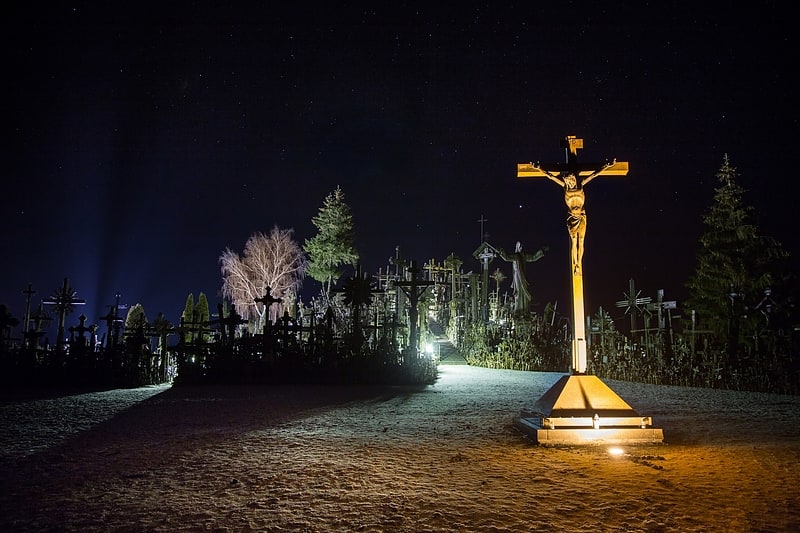
Also known as: Kryžių kalnas
Place of pilgrimage with 100,000 crosses . Hill of Crosses is a site of pilgrimage about 12 km north of the city of Šiauliai, in northern Lithuania. The precise origin of the practice of leaving crosses on the hill is uncertain, but it is believed that the first crosses were placed on the former Jurgaičiai or Domantai hill fort after the 1831 Uprising. Over the generations, not only crosses and crucifixes, but statues of the Virgin Mary, carvings of Lithuanian patriots and thousands of tiny effigies and rosaries have been brought here by Catholic pilgrims. The exact number of crosses is unknown, but estimates put it at about 55,000 in 1990 and 100,000 in 2006. It is a major site of Catholic pilgrimage in Lithuania.[4]
Address: Jurgaiciu k., Meskuiciu sen., Siauliu r., 81439 Siauliai
Trakai Island Castle, Trakai
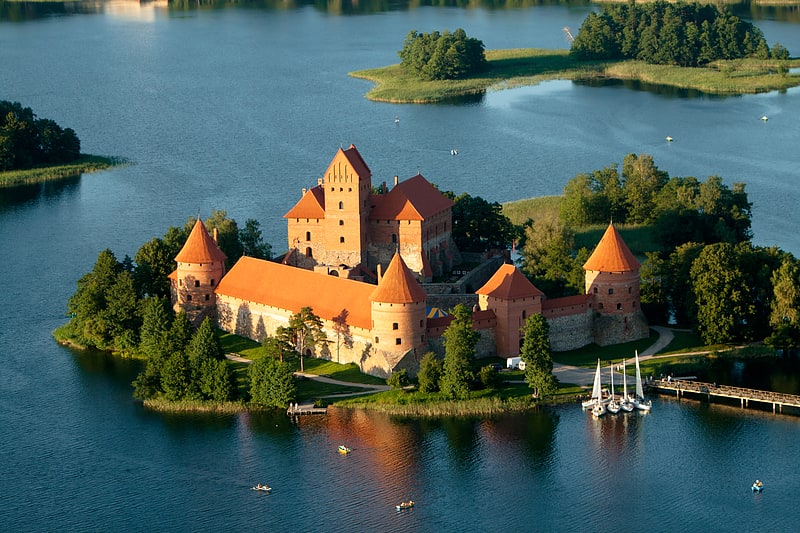
Also known as: Trakų salos pilis
Museum in Trakai, Lithuania. Trakai Island Castle is an island castle located in Trakai, Lithuania, on an island in Lake Galvė. The construction of the stone castle was begun in the 14th century by Kęstutis, and around 1409 major works were completed by his son Vytautas the Great, who died in this castle in 1430. Trakai was one of the main centers of the Grand Duchy of Lithuania and the castle held great strategic importance. The castle was rebuilt in the 1950s–1960s by Lithuanian initiative, although it had received resistance from Soviet authorities. The Trakai History Museum was established after the reconstruction.[5]
Address: Lake Galvė, Trakai
Kaunas Cathedral Basilica, Kaunas
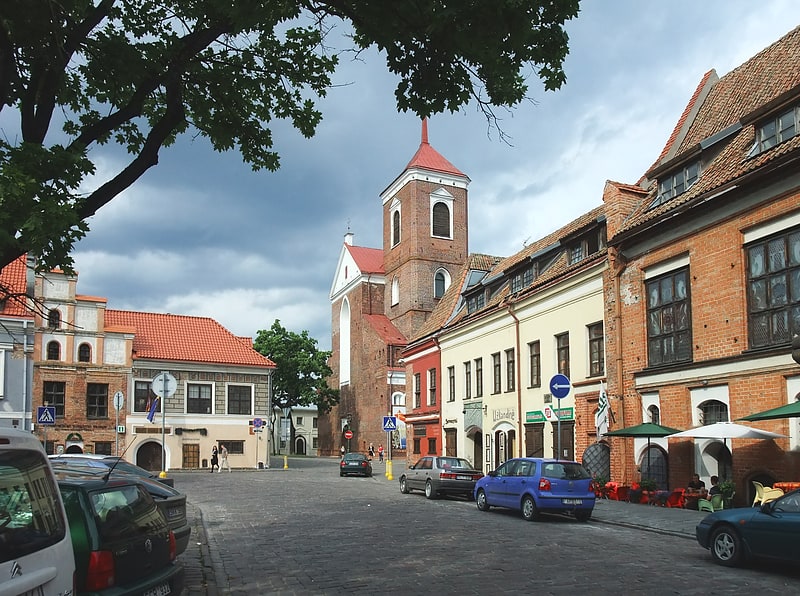
Also known as: Kauno Šv. apaštalų Petro ir Povilo arkikatedra bazilika
Historic church with ornate decor. Cathedral Basilica of apostles St. Peter and St. Paul of Kaunas is a Roman Catholic cathedral basilica in Kaunas, Lithuania.[6]
Address: Vilniaus g. 1, 44281 Kaunas
Lithuanian Zoo, Kaunas
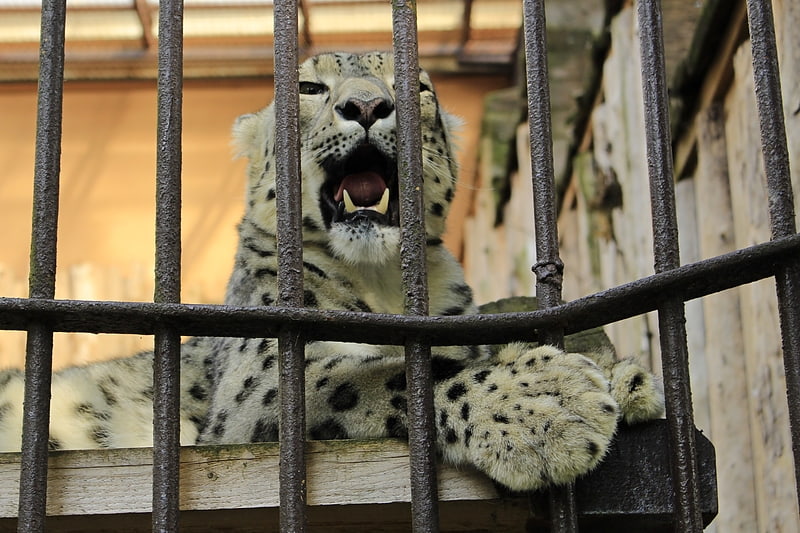
Also known as: Lietuvos zoologijos sodas
Traditional zoo with diverse species. Lithuanian Zoological Garden previously known as Kaunas' Zoological Garden is the oldest scientific zoo in Lithuania. It is located in an Ąžuolynas oak grove park in the south-western Žaliakalnis elderate of Kaunas. The territory of the zoo is 15.66 hectares.
The zoo was initiated in 1935 by famous Lithuanian zoologist Tadas Ivanauskas and opened on 1 July 1938 with 40 animals. These creatures were either personally owned by T. Ivanauskas or were gifts from other zoos. Within one year, the number grew to 150. The zoo currently has 2166 animals, and is classed as a medium-size zoo according to European zoo standards. It experienced funding difficulties during the 2000s.[7]
Address: 21 radvilėnų pl, Kaunas
Pažaislis Monastery, Kaunas

Also known as: Pažaislio vienuolynas
Tours of a baroque monastery and church. Pažaislis Monastery and the Church of the Visitation form the largest monastery complex in Lithuania, and the most renowned example of Baroque architecture in the country. The church is the most marble-decorated Baroque church of the former Grand Duchy of Lithuania. It is situated in the Petrašiūnai elderate of Kaunas, Lithuania, on a peninsula in the Kaunas Reservoir near the Kaunas Yacht Club. It was declared a cultural monument and a site of Catholic pilgrimage in Lithuania. In 2021, Pažaislis Church and Monastery Complex was awarded as the best European Film location in 2020 during the 2021 Berlin International Film Festival.[8]
Address: T. Masiulio G. 31, Kaunas, 52436 Kaunas
Palanga Amber Museum, Palanga
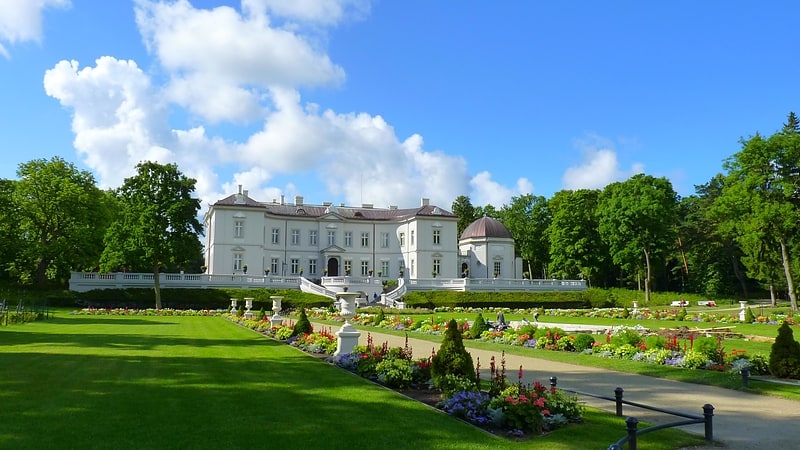
Also known as: Palangos gintaro muziejus
Museum in Palanga, Lithuania. The Palanga Amber Museum, near the Baltic Sea in Palanga, Lithuania, is a branch of the Lithuanian Art Museum. It is housed in the restored 19th-century Tiškevičiai Palace and is surrounded by the Palanga Botanical Garden. The museum's collection of amber comprises about 28,000 pieces, of which about 15,000 contain inclusions of insects, spiders, or plants. About 4,500 pieces of amber are exhibited; many of these are items of artwork and jewelry.[9]
Address: Vytauto g. 17, 00135 Palanga
Užutrakis Manor, Trakai
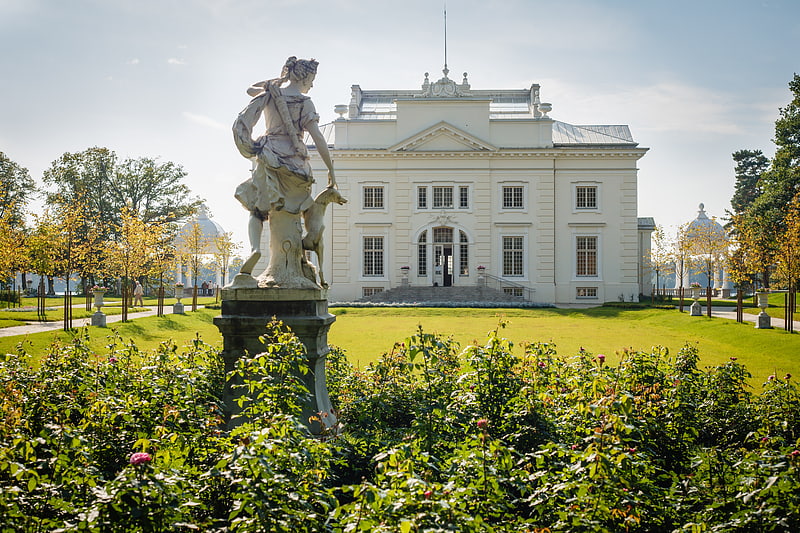
Užutrakis Manor is a late 19th-century residential manor of the Tyszkiewicz family in Užutrakis, on the shore of Lake Galvė, opposite the famous Trakai Castle.
It is considered one of the most important monuments of Lithuania’s estate heritage.[10]
Address: Užutrakio st., Trakai
Tiškevičiai Palace, Palanga
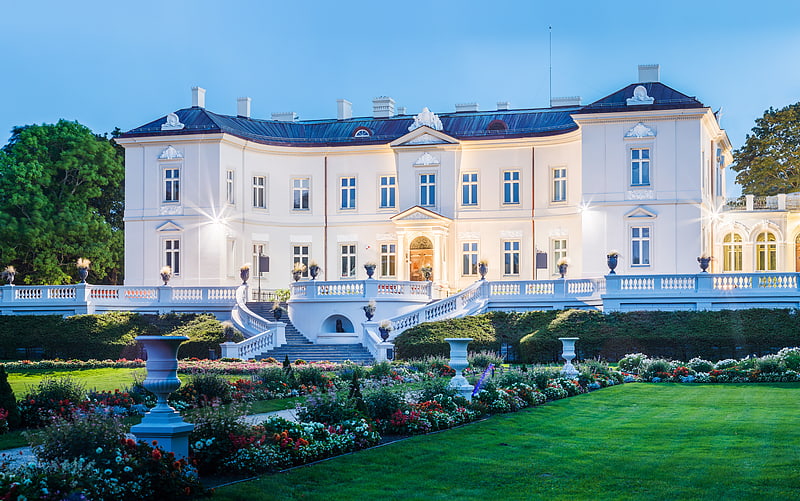
Also known as: Palangos dvaras
Palace in Palanga. The Tiškevičiai Palace, Tiskevičius Palace, or Tyszkiewicz Palace is a Neo-Renaissance style building in Palanga, Lithuania, built for the Tyszkiewicz family. The construction was started in 1893 and finished in 1897. The palace is surrounded by a park with ponds, fountains, and collections of rare plants. Since 1963 the palace has housed the Palanga Amber Museum and is surrounded by the Palanga Botanical Garden.[11]
Address: 17 Vytauto g, Palanga
Trakai Kenesa, Trakai

Also known as: Trakų kenesa
Church in Trakai, Lithuania. Trakai Kenesa is the kenesa of the Qaraite Jewish community in Trakai, Lithuania, and a rare example of one of the surviving kenesas of the former Polish–Lithuanian Commonwealth. It was built in the 18th century, restored in the 1890s and is still in use.[12]
Address: Karaimų g. 30, 21106 Trakai
Skulptūrų parkas, Klaipėda
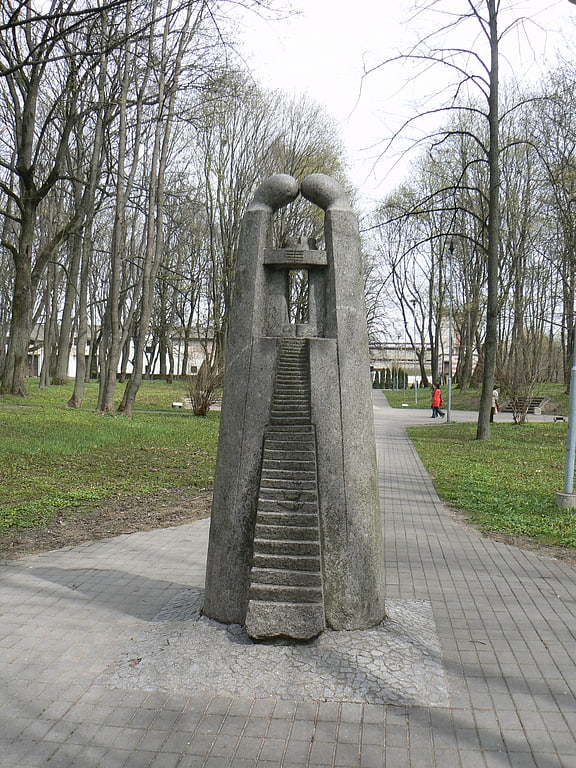
Klaipėda Sculpture Park is located in central Klaipėda, Lithuania. This park is one of the key artistic landmarks in the town. The L-shaped park occupies 12.2 hectares and has 116 modern sculptures created by 67 Lithuanian artists in 1977–1991. QR codes have been fixed to the sculpture plaques, giving extra info after waving a phone next to them.
In 1820–1959 here was the Memel Central Cemetery (German: Memel Städtischer Friedhof). Over 40,000 people are buried there. Some graves are marked by tombstones to this day.
Since 2006 the History Museum of Lithuania Minor is responsible for maintenance of the park.[13]
Snow Arena, Druskininkai
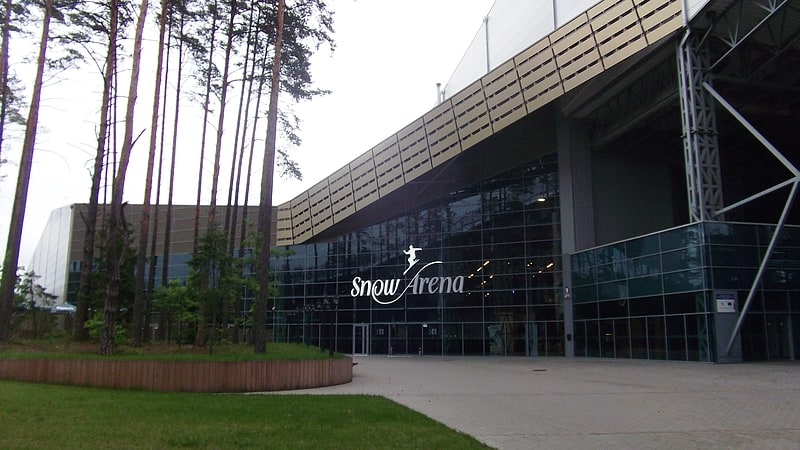
Arena in Lithuania. The Snow Arena is an indoor ski slope in Druskininkai, Lithuania. It was opened on August 26, 2011.
It is one of the biggest indoor skiing slopes in the world, with the slope length of 460 metres (1,510 ft), width 50 metres (160 ft) and height of between 65.65 metres (215.4 ft) and 150 metres (490 ft) at the beginner slope. The indoor ski area is divided into two segments: terrain park and ski slope. A seasonal outdoor route of 640 metres (2,100 ft) is also available when the average outdoor temperatures fall below +5°C.
Snow at Snow Arena is made by using PowderStar Series technology. Water and air are the only ingredients of the snow with no chemical or bacteriological additives used. The interior temperature of the hall, which is open all year round, is kept at a constant −2 to −4 °C (28.4 to 24.8 °F).
There are two ski lifts in the Snow Arena: a platter lift and a chair lift. There is also a Magic carpet (ski lift) for the beginner slope. Snow Arena offers ski rentals and lessons with the skiing school established at the arena, offers a wide range of programs for all abilities and offers group bookings for schools and businesses. It also has a small store that sells gloves, helmets and socks and offers a range of off-snow services, including four restaurants and two licensed bars.
Cost of arena is estimated to be around €30 million.[14]
Address: Nemuno Kelias 2, 67308 Druskininkai
Šiauliai University Botanical Garden, Šiauliai
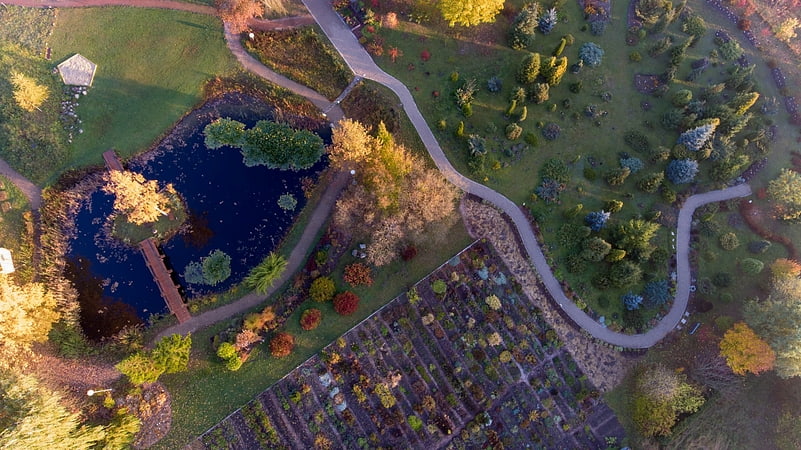
Šiauliai University Botanical Garden is a botanical garden established in 1997 and operated by the Šiauliai University, and located at Paitaičių str. 4, Šiauliai, Lithuania.
Botanical Garden is a member of the Lithuanian Association of University Botanical Gardens (LAUBG), the Association of Baltic Botanic Gardens (ABBG), the Botanic Garden Conservation International (BGCI) and the Network of Botanic Gardens in the Baltic Sea Region.[15]
Grūtas Park, Druskininkai
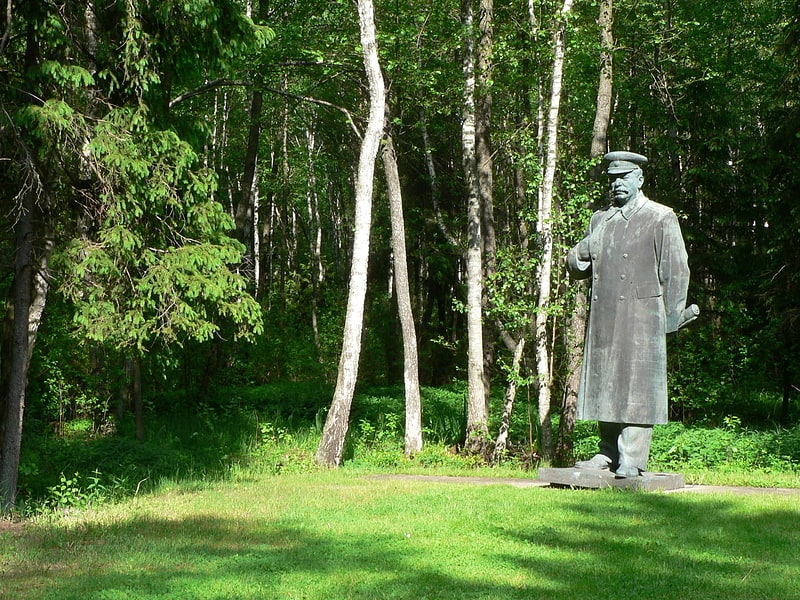
Also known as: Grūto parkas
Park exhibiting old Soviet sculptures. Grūtas Park is a socialist realism museum with a sculpture garden of Soviet-era statues and other Soviet ideological relics from the times of the Lithuanian SSR. Founded in 2001 by a mushroom magnate Viliumas Malinauskas, the park is located near Druskininkai, about 130 kilometres southwest of Vilnius, Lithuania. The park requires an entrance fee.[16]
Švyturio arena, Klaipėda

Arena in Klaipėda, Lithuania. Švyturio Arena is an indoor arena in Klaipėda, Lithuania. The arena is named after the company Švyturys, which bought the rights for the name. The capacity of the catamaran-shaped arena is 6,200 seats for basketball games, 4,416 for ice hockey games, 6,512 for boxing/wrestling matches, and 7,450 seats for concerts.[17]
Address: Klaipėda, Dubysos g. 10
Klaipėda Castle, Klaipėda

Also known as: Klaipėdos pilis
Museum in Klaipėda, Lithuania. Klaipėda Castle, also known as Memelburg or Memel Castle, is an archeological site and museum housed in a castle built by the Teutonic Knights in Klaipėda, Lithuania, near the Baltic Sea. The Teutons called the castle Memelburg or Memel, and Klaipėda was generally known as Memel until 1923, when Lithuanian military forces took over the city. The castle was first mentioned in written sources in 1252, and underwent numerous destructions and reconstructions in the centuries that followed. During the 19th century, having lost its strategic importance, the castle was demolished. Archeological work was performed at the site during the 20th century, and in 2002 a museum was established underneath one of its bastions. Currently, the castle is being restored. The construction work is not scheduled to finish until 2020.[18]
Address: Žvejų g. 27T, 91241 Klaipėda
Žemaičių Alka, Palanga
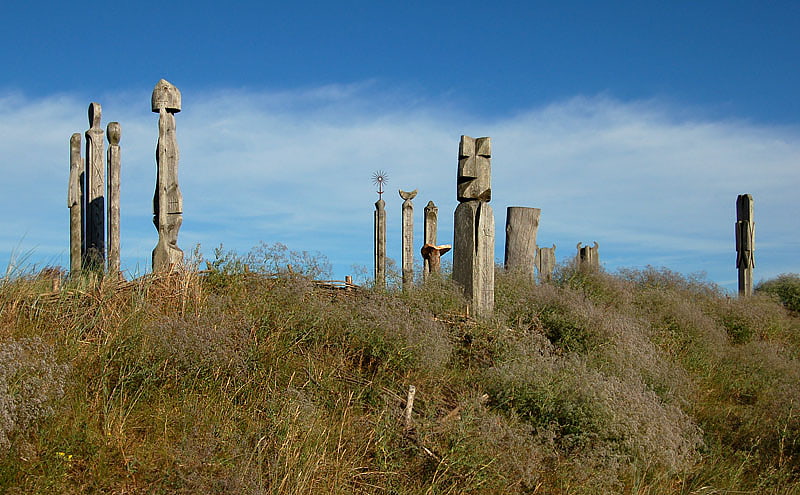
Samogitian Sanctuary is a pagan sanctuary in Šventoji, Lithuania, a reconstruction of a medieval pagan observatory. The poles corresponding to the gods and goddesses of the Balts can be used to observe the main calendar holidays.
It is based on archeological records of the paleoastronomic observatory and pagan shrine that existed on Birutė Hill in Palanga until the 16th century. The wooden poles were carved by Lithuanian folk artists and were installed in June 1998. Neopagans use the sanctuary for devotional ceremonies during the major holidays.[19]
Cido Arena, Panevėžys
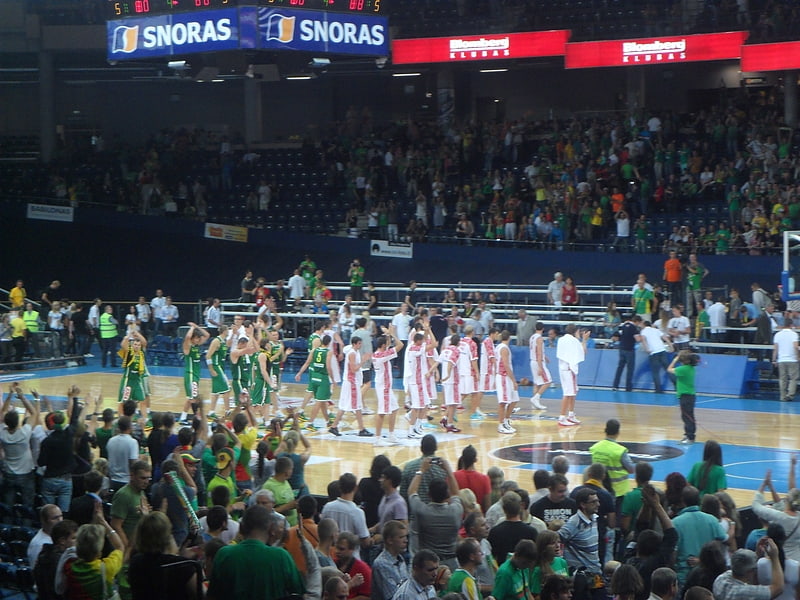
Also known as: Cido arena
Arena in Panevėžys, Lithuania. Cido Arena is the largest multifunctional arena in Panevėžys, Lithuania. It generally hosts track cycling events, as well as basketball games and concerts. The basketball club BC Lietkabelis, which currently competes in the domestic LKL league, uses the facility for all of its LKL home fixtures. It was opened on October 24, 2008. It replaced Sports Palace Aukštaitija as the home of BC Lietkabelis. The arena boasts an indoor 250 m long Olympic cycling track, the only one in the Baltic States.
The arena hosted the FIBA EuroBasket 2011 Group A matches and the European Track Championships.
In 2021 Velodrome hosted the second stage of inaugural 2021 UCI Track Champions League.[20]
Address: Panevėžys, Parko g. 12
Cathedral of Saints Peter and Paul, Šiauliai
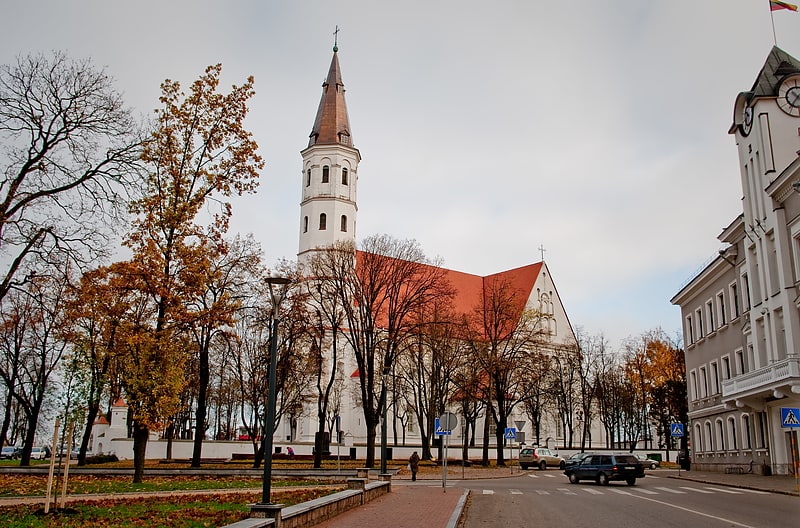
Also known as: Šiaulių Šv. apaštalų Petro ir Pauliaus katedra
Catholic church in Šiauliai, Lithuania. The Sts. Peter and Paul Cathedral also called Šiauliai Cathedral is a religious building of the Catholic Church that serves as the cathedral in Šiauliai, a city in the European country of Lithuania, and the seat of the Roman Catholic Diocese of Šiauliai.[21]
Joy of all who Sorrow Church, Druskininkai
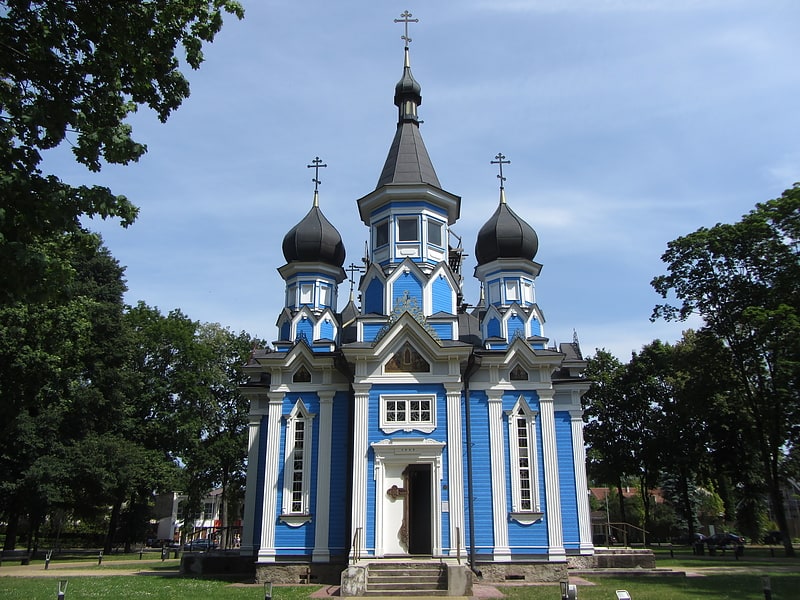
Also known as: Druskininkų Dievo Motinos ikonos „Visų liūdinčiųjų Džiaugsmas“ cerkvė
Russian orthodox church in Druskininkai, Lithuania. Joy of all who Sorrow Church is an Eastern Orthodox church in Druskininkai, Lithuania. It is dedicated to the icon of the Joy of All Who Sorrow.
The church was built in 1865, after Druskininkai become a highly popular spa town visited by many wealthy Russians. The vice-governor of Grodno, Yakov Rozhnov, announced a collection of funds in the whole country. Among the contributors, there was the granddaughter of general Mikhail Ilarionovich Kutuzov, Iekaterina, who offered the sum needed for the construction of the iconostasis. Rozhnov himself also donated ten thousand rubles. The church was built between 1861 and 1865. Up from 1890, the Orthodox parish in Druskininkai also ran a school for girls of different confessions.
In 1915, when World War I started, most of the Russian Orthodox inhabitants of Druskininkai left the town. However, after the Vilnius region was annexed by Poland, the town - and so the parish - become a local center of White Russian emigration. Because of that, the church was closed in 1944, after Red Army entered Druskininkai. At this time there was around 350 Orthodox Christians in Druskininkai and the Soviet government agreed to reopen the parish in 1947. In addition, ten years later, the church was renovated. It still houses a parish, although the number of the parishioners has been falling since the 1970s.[22]
Address: 2 Laisvės a, Druskininkai
Cathedral of St. Anthony of Padua, Telšiai
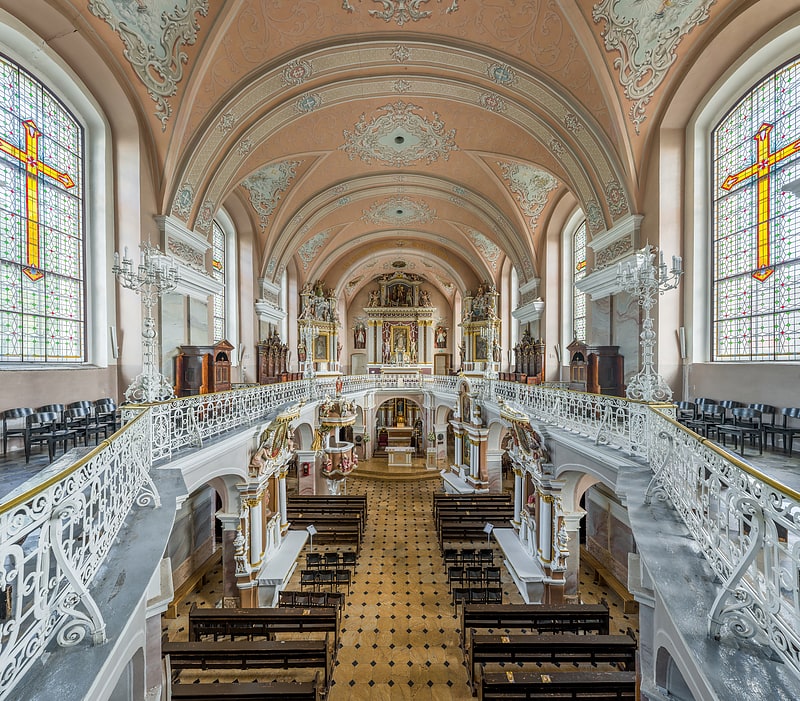
Also known as: Telšių Šv. Antano Paduviečio katedra
Cathedral in Telšiai, Lithuania. The Cathedral of St. Anthony of Padua is a Roman Catholic cathedral in Telšiai, Lithuania, seat of the Roman Catholic Diocese of Telšiai.[23]
Address: Katedros a. 2, 87130 Telšiai
Kretinga Museum, Kretinga
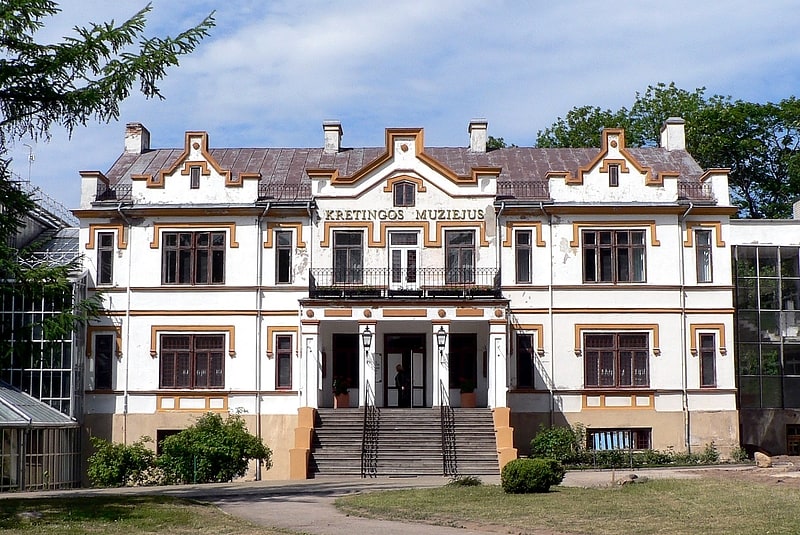
Also known as: Kretingos muziejus
Museum in Kretinga, Lithuania. The Kretinga Museum, also known as Kretinga Manor, is located near the Baltic Sea in Kretinga, Lithuania. Originally a private estate, it was converted to a museum in 1992, and now contains a number of archeological finds, fine and applied art collections, folk art, and ethnographic exhibits, as well as a restored orangery. Nearby is a sculpture garden featuring a reconstruction of a Lithuanian solar calendar. The museum is operated by the Kretinga district municipality.[24]
Address: Vilniaus g. 20, 97104 Kretinga
Jurgis Ambroziejus Pabrėža grave chapel, Kretinga
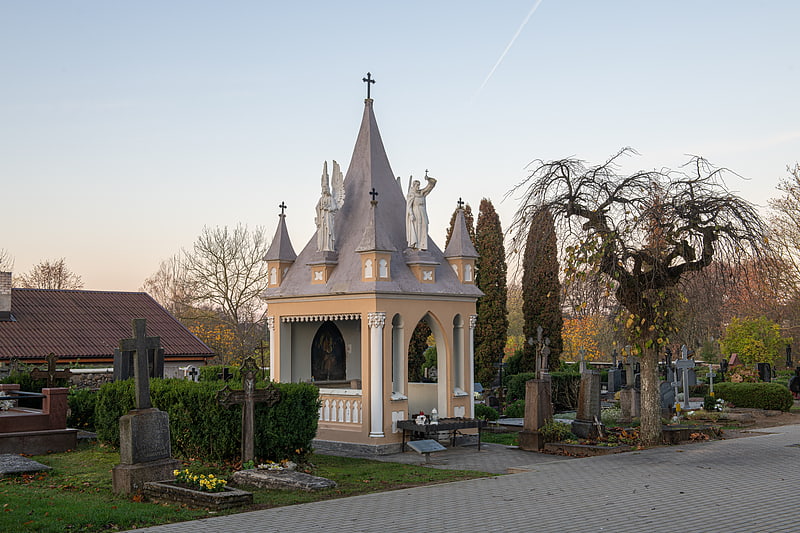
Jurgis Ambroziejus Pabrėža grave chapel is a small neo-Gothic masonry chapel above the grave of monk and botanist Jurgis Pabrėža in the old graveyard of Kretinga, Lithuania. It was built in 1933.
The shape of the chapel's roof is like a pyramid with four slopes, in the corners there are four rectangular pyramidal four-sloped turrets with iron crosses at their tops, while between the turrets four concrete sculptures stand upon rectangular pedestals: St. Francis and the angels. In the interior of the chapel, there is a mural of "Virgin Mary the Eternal Saviour" by an unknown artist. The maintenance and restoration of the chapel was performed by sporadic craftsmen, and the painting within the chapel was painted over multiple times. In 1993, the Jurgis Ambroziejus Pabrėža Grave Chapel was added to the registry of cultural heritage objects.
Many people in Samogitia believe Pabrėža to be a saint. It is said that those who visit his grave sometimes experience miracles; thus, the candles in the chapel are kept lit all year round.[25]
Linkmenas, Aukštaitija National Park
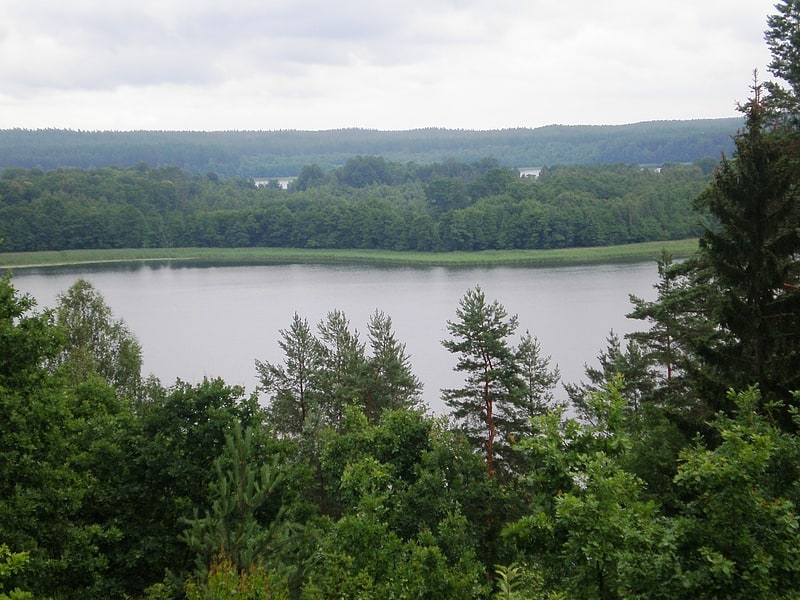
Lake in Lithuania. Lake Linkmenas is a lake in Aukštaitija National Park, Ignalina District, Lithuania. It is 2,300 metres long and 600 metres wide. Linkmenas is part of a chain of seven interconnected lakes. The only major settlement on the shore is Ginučiai, which has an old watermill.[26]
Bernadine Monastery, Kretinga
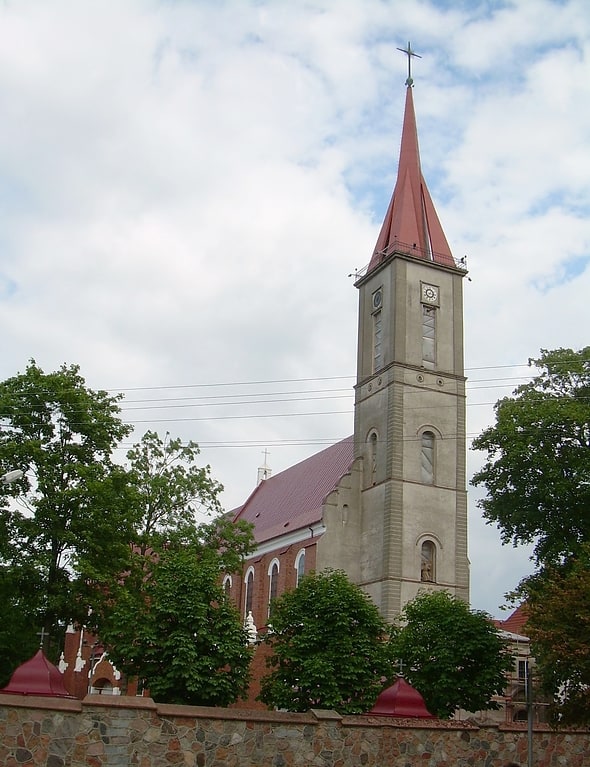
Catholic church in Kretinga, Lithuania. The Bernadine Monastery and Church of the Annunciation to the Blessed Virgin Mary in Kretinga, Lithuania, is one of the oldest churches and the first monastery in Samogitia. The masonry buildings of the monastery and the church were built in 1605–1617. They were sponsored by a nobleman of the Polish–Lithuanian Commonwealth, Jan Karol Chodkiewicz, on his wife's initiative, and the development of the whole town of Kretinga is directly tied to the establishment of the Franciscan monastery.[27]
Address: 2 Vilniaus g, Kretinga
Tauragnas, Aukštaitija National Park
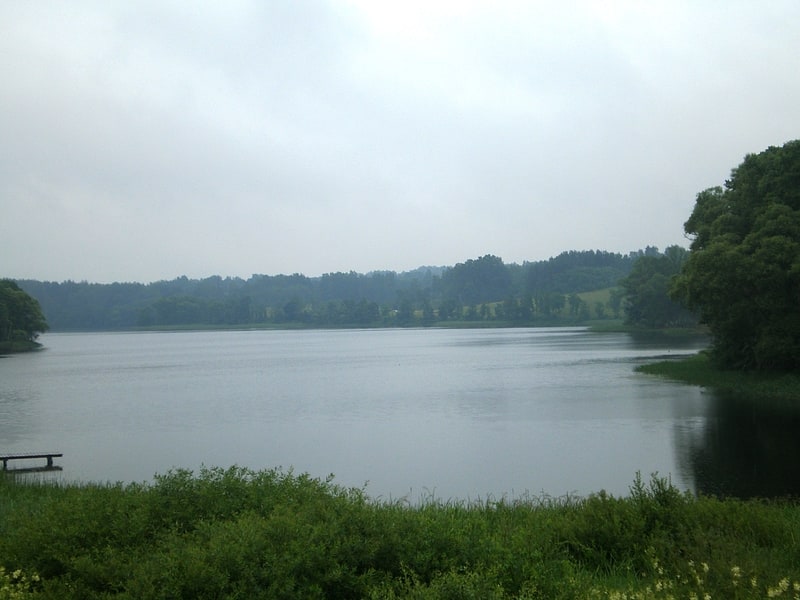
Deep, serene lake surrounded by trees. Tauragnas is the deepest lake in Lithuania reaching 62.5 metres of depth. The surface area is 5.13 km2 and average depth 18.7 m. It is situated in Aukštaitija National Park near Tauragnai in Utena County. This is also a lake with the highest altitude in Lithuania.[28]
Nida Lighthouse, Nida

Also known as: Nidos švyturys
Lighthouse in Lithuania. Nida Lighthouse is located in Nida, on the Curonian Spit in between the Curonian Lagoon and the Baltic Sea.[29]
Plungė Manor, Plungė
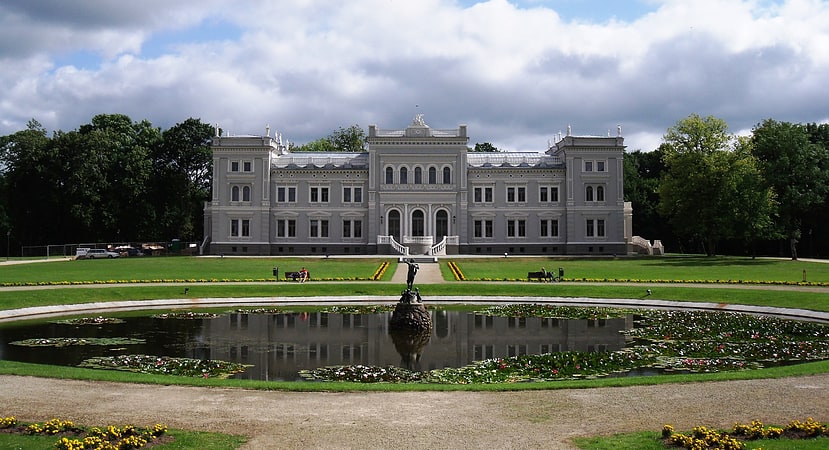
Also known as: Plungės dvaras
Museum in Plungė, Lithuania. Plungė Manor is a former Ogiński residential manor in Plungė, Lithuania. It now harbors the Samogitian art museum.[30]
Address: Parko g. 3B, Plungė
Alksnaitis, Aukštaitija National Park

Lake in Lithuania. Alksnaitis is a lake in the Ignalina district, eastern Lithuania. It is located in the Aukštaitija National Park, about 3.5 kilometres northwest of Linkmenys village. The lake connects with Alksnas, Ūkojas and Linkmenas lakes.[31]
Port of Nida, Nida
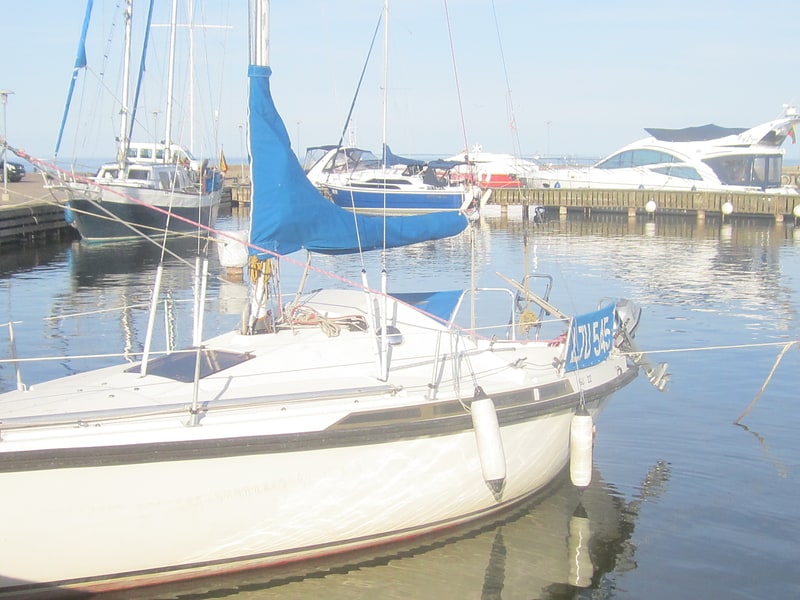
Also known as: Nidos uostas
Marina in Nida, Lithuania. The Port of Nida is a port in the city of Nida, Lithuania. It is located on the Curonian Lagoon side of the Curonian Spit. It is mostly used for ferries, connection with inland Lithuania and fishing.
The port is located in the oldest part of the town that preserves the initial strict rectangular plan. It started at the end of the 19th century as a fishing port, later extended as a steamboat port.
During Soviet times fishing base was significantly extended, demolishing the former custom office, hotel and part of the old fisherman houses. During this time Port of Nida also started to serve as the terminus of the Kaunas - Nida hydrofoil route (through Nemunas). This route has been discontinued for some time but some sources claim might be available again.
In 1991, the second pier has been was added for passenger boats. Since 1999 the port has been granted the rights of the international port, deciding to restore the border control office. With custom and immigration offices available, Nida Yacht-Club is now capable of accepting sailors from the whole world.
Currently the port has the two mooring piers, one for fishing and another for passenger boats. The passenger part has the constant 3 m. depth and 25 m. width. The depth of the fishing section varies between is 2.8–3 m at the center of the pier but drops till 1 m in other places. The port can accommodate 40-60 yachts in total.[32]
Telšiai Bernardine Monastery, Telšiai
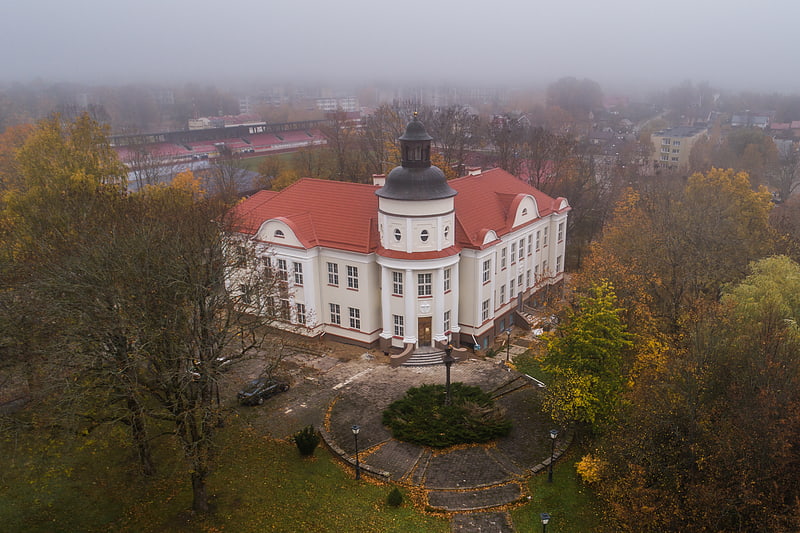
Telšiai Bernardine monastery and seminary complex – is one of the most important sacred buildings in Samogitia, Lithuania.[33]
Nemunas Delta, Nida
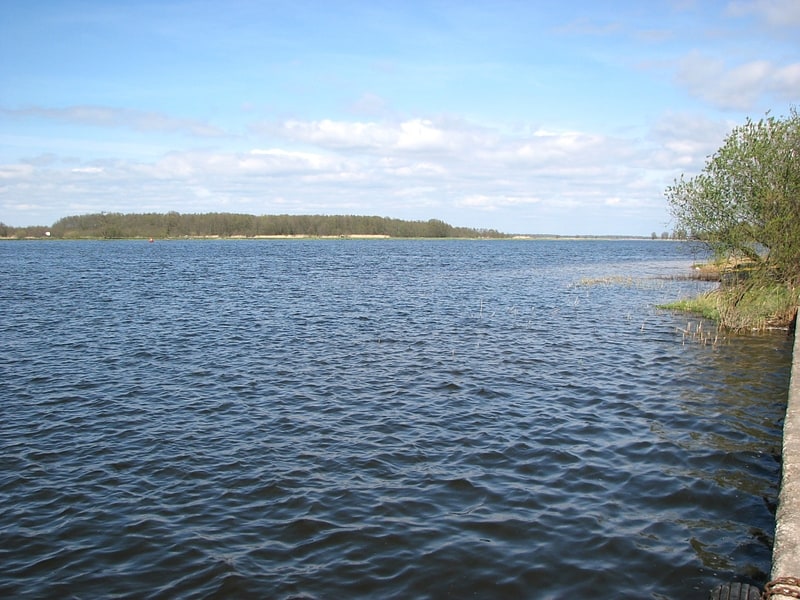
Also known as: Nemuno delta
Nemunas Delta is the Lithuanian name for the Neman River Delta, in Lithuania. Prior to post-World War II border changes, it was known in German as the Memel Niederung, as the Neman was for centuries called the Memel in German.
When it reaches the Baltic Sea, the Neman splits into a maze of river branches and canals, forming polders and wetlands that make it a very attractive destination for eco-tourism. The four main distributaries are Atmata, Pakalnė, Skirvytė and Gilija. In the centre of the delta lies Lithuania's largest island, Rusnė Island (5 km²), and its eponymous village. Although it is the largest human settlement in the delta, its population is only about 2,500.[34]
Holy Transfiguration Church, Kėdainiai
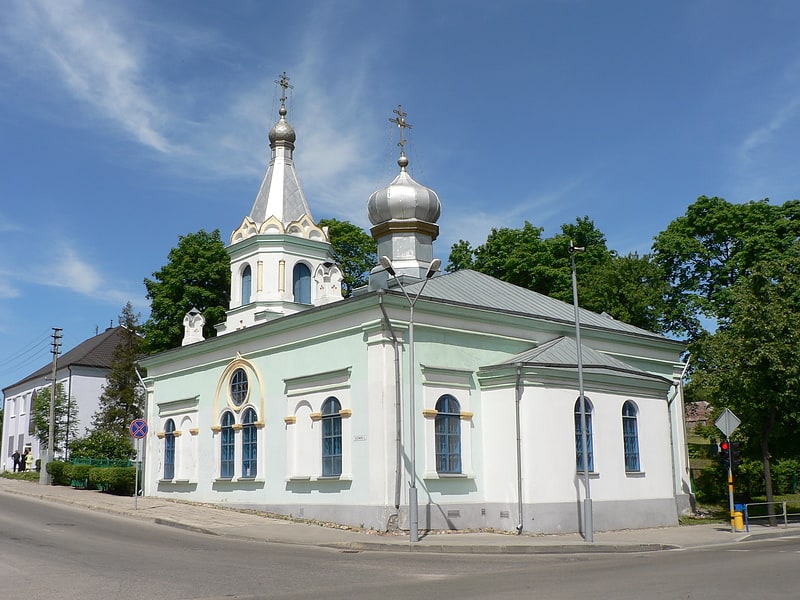
Also known as: Kėdainių Viešpaties Atsimainymo cerkvė
Orthodox church in Kėdainiai, Lithuania. Holy Transfiguration Church is an Eastern Orthodox church in Kėdainiai.
The first, wooden Orthodox church in Kėdainiai was constructed in 1643. From 1652 it belonged to an Orthodox monastery of the Holy Transfiguration, which was destroyed by fire in 1771. After this event the monastery was never rebuilt and the monks moved to the Holy Spirit Monastery in Vilnius. In 1798 it was officially closed. Despite the advice of the Holy Synod of the Russian Orthodox Church, the remaining church was not made a parish church because of the tiny number of Orthodox Christians living permanently in Kėdainiai. The services were held there only occasionally, wherever a Russian military unit arrived to the town.
In 1841 this situation changed together with the arrival of more Russians to the town. In 1895 the church also turned out to be too tiny and it was replaced by the one which was preserved up to today. During World War I, the church was abandoned. Only in 1918 new parish clergy arrived to Kėdainiai. It was registered as an active parish by the Soviet government in 1947, with 230 parishioners at this moment.[35]
Address: Gedimino g. 2, 57287 Kėdainiai
Church of The Assumption, Telšiai
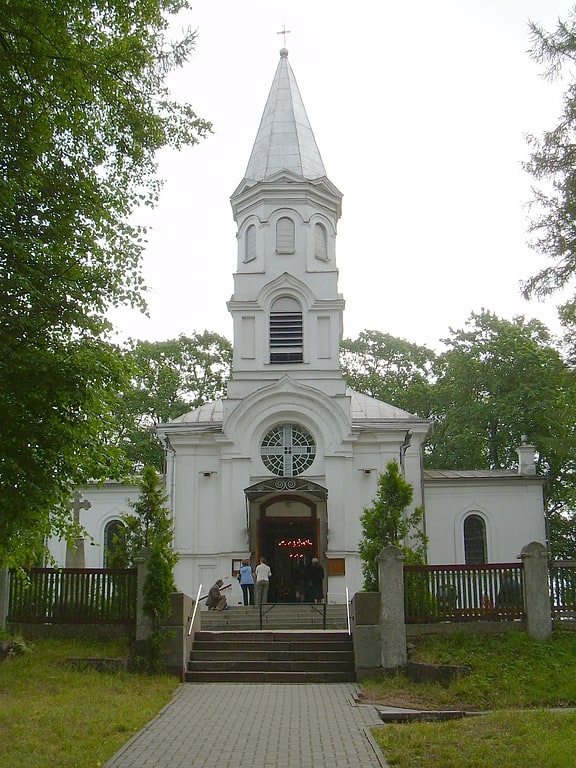
Also known as: Telšių Švč. Mergelės Marijos Ėmimo į dangų bažnyčia
Catholic church in Telšiai, Lithuania. The Church of the Assumption of the Blessed Virgin Mary into Heaven is a Roman Catholic church in Telšiai, Lithuania.[36]
Address: Šviesos g. 2, 87127 Telšiai
Church of St. Peter and St. Paul, Žemaitija National Park
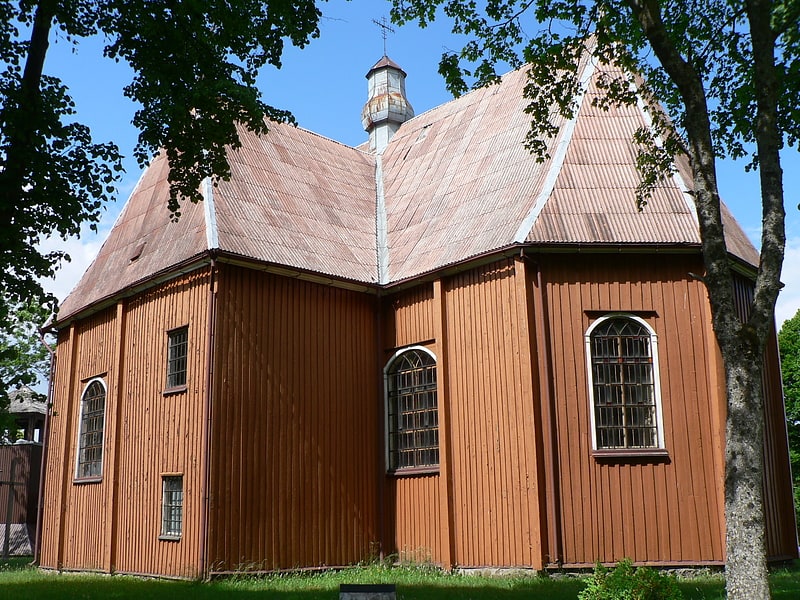
Catholic church in Plateliai, Lithuania. Church of St. Peter and St. Paul the Apostles is a Roman Catholic church located in Plateliai, Plungė District Municipality, Lithuania. It is part of the nationally significant sacral heritage. The complex consists of the church built in 1744 and the bell tower built in 1899.[37]
Address: 15 Didžioji g, Žemaitija National Park
Bistrampolis Manor, Panevėžys
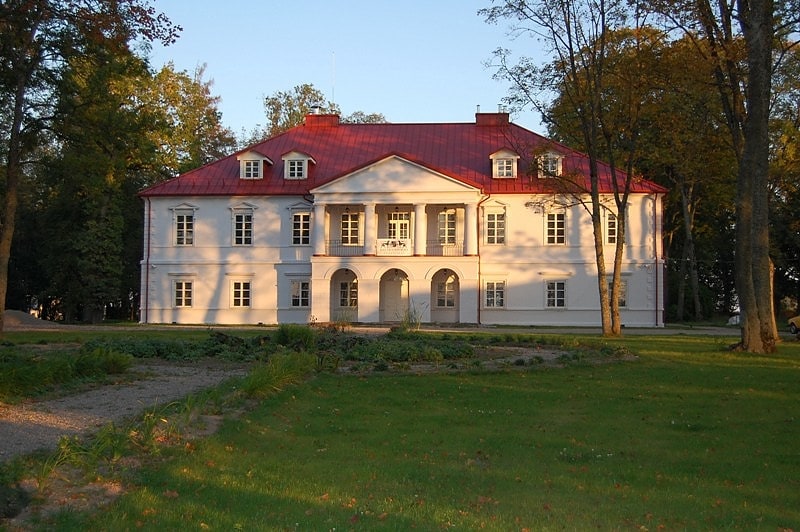
Also known as: Bistrampolio dvaras
Hotel in Lithuania. Bistrampolis Manor is a former residential manor in Kučiai, Panevėžys district. Currently it is used as a hotel and coffee-restaurant. The manor stables are used as a concert hall, where various festivals takes place. The chapel is used as a museum of Lithuanian book smugglers. Bistrampolis Manor is also famous for its park.[38]
St John the Baptist chapel, Plungė
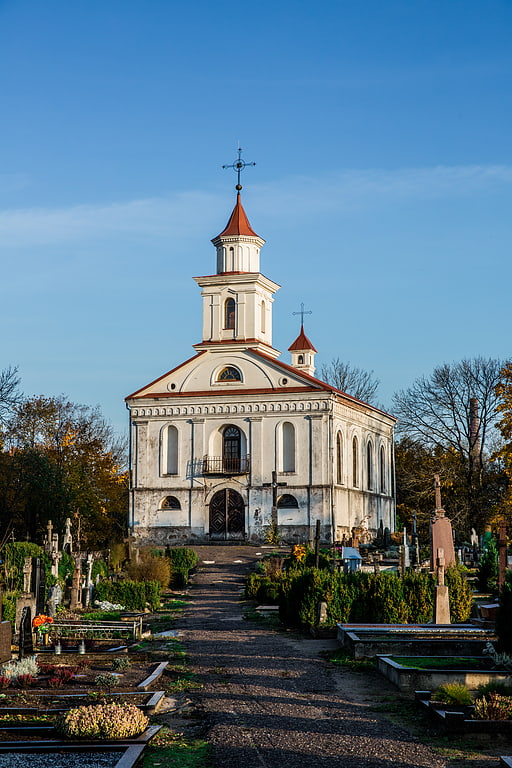
St John the Baptist chapel, also called the All Saints Chapel or the Zubov Chapel, is a chapel built in the Romantic Classical style located in the old graveyard of Plungė City, Lithuania. It is said that it was built by local craftsmen, funded by one of the Zubov counts and the parishioners. In the chapel, members of the Zubov family are buried, as well as the families of other noblemen from the surrounding areas – Lešcevski, Vaitkevičius and Moikovskis.[39]
Kėdainių evangelikų reformatų bažnyčia, Kėdainiai

Church
Address: 3 Senoji g, Kėdainiai
Dauniškis, Utena

Lake in Lithuania. Dauniškis is a lake located in Dauniškis park, Utena city, Lithuania. It has a length of 0.7 km and maximum width of 0.3 km.[40]
Anykščiai Church, Anykščiai
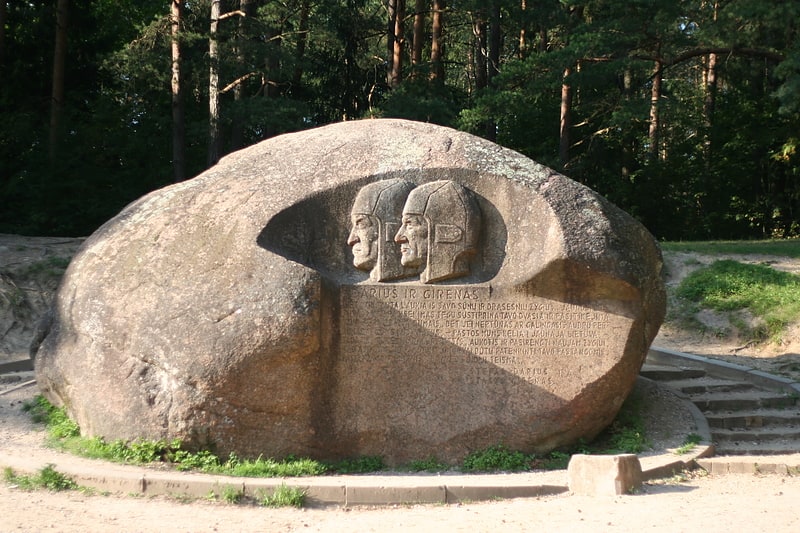
Also known as: Anykščių Šv. apaštalo evangelisto Mato bažnyčia
Catholic church in Anykščiai, Lithuania. Church of Apostle Evangelist St. Matthew in Anykščiai is a red brick Neo-Gothic church in Anykščiai, Lithuania. The Church is situated on the right bank of the Šventoji River. The twin spires of the church, each 79 metres in height, make the church the tallest in Lithuania. The brightly colored stained glass windows were the creation of Anortė Mackelaitė, the well known stained glass artist of Lithuania, between 1971 and 1986.[41]
Address: Vilniaus g. 8, 29147 Anykščiai
Church of St. Stanislaus the Bishop, Žemaitija National Park

Church of St. Stanislaus the Bishop is a wooden Roman Catholic church in Beržoras, Plungė District Municipality, Lithuania. The church complex includes a 14-station outdoor Way of the Cross.[42]
Address: 2 Gaso g., Žemaitija National Park
Kėdainių rotušė, Kėdainiai
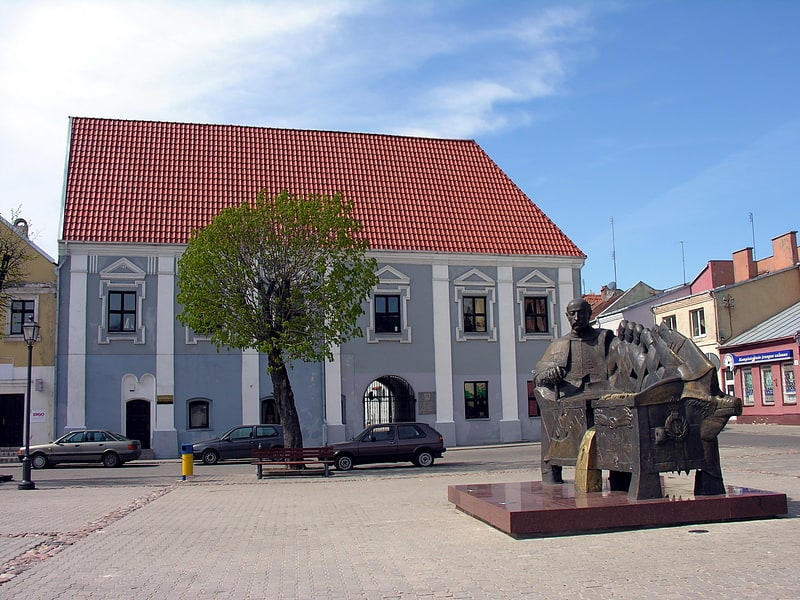
Kėdainiai Town Hall is one of the three Renaissance -style town halls surviving in Lithuania. Stands in the Great Market Square. Address: Didžioji g. 1, Kedainiai. A two -story brick corner plan building.
Exhibitions, various representative and cultural events, concerts take place at the Town Hall. The works of the Town Hall Sculpture are exhibited by the works of Lithuanian sculptors. Since 1991 Until 2002, the Town Hall Art Gallery was operating here, exhibitions of Lithuanian and foreign professional art were held in the exhibition halls, symposia, plein airs, concerts and other cultural events of the city were held. Currently located in the Town Hall, the Civil Registration Department is located. The works of artists are exhibited in the 1st floor.
Previously, there was a prison and archives in the basement of the Town Hall, on the ground floor - shops, and on the second floor, a magistrate's work room and courtroom. One of the first pharmacies in Lithuania was established in the Town Hall.
Address: Radvilų g. 11. Korespondencijai - J. Basanavičiaus g. 27-19, Kėdainiai
Beit Medrash Hagadol Synagogue of Jonava, Jonava

Also known as: Jonavos Beit Midrash Hagadol sinagoga
Synagogue in Jonava. The Beit Medrash Hagadol Synagogue of Jonava, also known as White Synagogue of Jonava, is a former synagogue in Jonava.[43]
Address: 12 Sodų g, Jonava
Jonava Synagogue of Merchants, Jonava
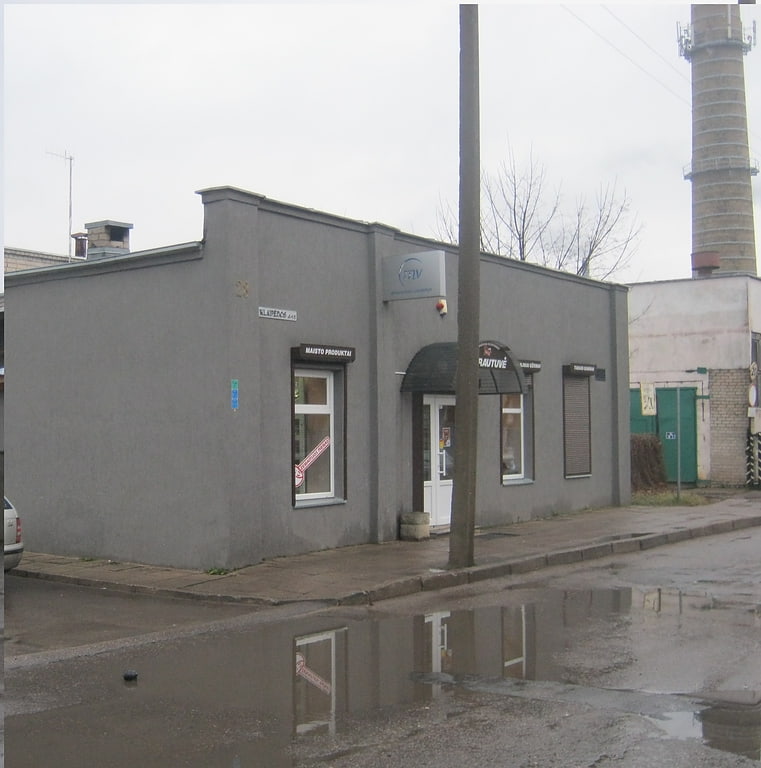
Synagogue. The Jonava Synagogue of Merchants is a former synagogue in Jonava.[44]
Panevėžys Cathedral, Panevėžys

Also known as: Panevėžio Kristaus Karaliaus katedra
Cathedral in Panevėžys, Lithuania. The Cathedral of Christ the King in Panevėžys, Lithuania, is a Roman Catholic cathedral, seat of the Roman Catholic Diocese of Panevėžys.[45]
Jonava Market, Jonava

Also known as: Jonavos turgus
The Jonava Market is a local market in the city of Jonava, Lithuania.[46]
Puntukas, Anykščiai
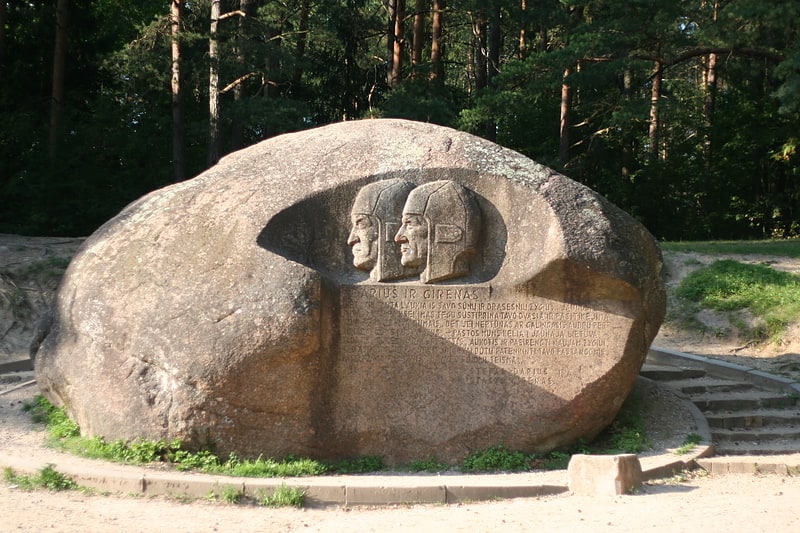
Puntukas is the second-largest boulder in Lithuania. It is situated some 5 kilometres south of Anykščiai on the left bank of the Šventoji River. It was believed to be the largest stone in Lithuania until the discovery of Barstyčiai stone in the Skuodas district in 1957.
Puntukas is a glacial erratic—it was brought by glaciers during the last glacial period (18th–12th millennium BC) probably from Finland. It measures 6.9 metres (23 ft) in length, 6.7 m (22 ft) in width, and 5.7 m (19 ft) in depth (including 1.5 m (4 ft 11 in) underground). It weighs about 265 tons. It is made of Rapakivi granite. Its reddish mass includes large crystals of potassium feldspar surrounded by green rings of oligoclase.
In 1943, sculptor Bronius Pundzius engraved portraits and quotes from last wills of Lithuanian pilots Steponas Darius and Stasys Girėnas for the 10th anniversary of their deaths during the transatlantic flight with Lituanica. A local legend has it that velnias (a devil in the Lithuanian mythology) carried the stone to destroy the Anykščiai Church, however a rooster crowed. The devil disappeared back into the underworld, leaving only Puntukas behind. The legend was featured in the famous poem Anykščių šilelis by Antanas Baranauskas. According to another story, a brave Lithuanian warrior Puntukas was killed and was burned (a usual pagan custom) on the stone; since then it is known as Puntukas stone. Other legends claim that the stone was a pagan shrine and that oaks growing around are relics of the sacred groves.[47]
Marijampolės kraštotyros muziejus, Marijampolė
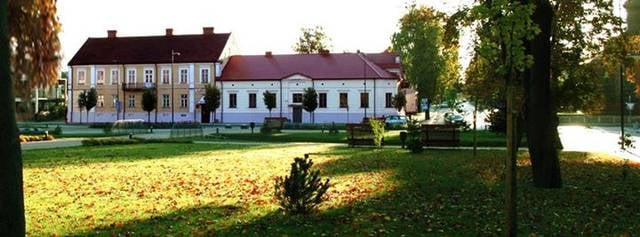
Top attraction, Museum
Address: 29 Vytauto g, Marijampolė